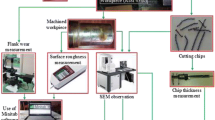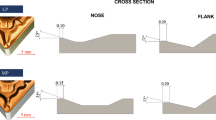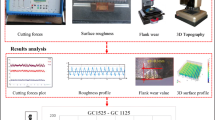Abstract
This paper compares the performances of uncoated carbide and coated cermet inserts for varied machinability aspects throughout the machining of hardened steel (AISI 4340, 48 HRC) in the dry cutting surroundings. Cutting speed, feed, and depth of cut were thought of as major governing parameters. Workpiece surface temperature, machining forces, and tool flank wear were taken as measures to check the performance estimation of various cutting inserts during this work. All the three input variables were ascertained to possess influence over workpiece surface temperature, feed, and radial force in case of uncoated carbide and cermet. Cermets exceeded the performance of carbides for flank wear, cutting force, and workpiece surface temperature, although carbides outperformed cermets concerning feed and radial force. The depth of cut was found to be the most vital, once feed and cutting forces were involved, whereas it had been true for radial force using carbides. Cutting speed affected workpiece surface temperature and flank wear for carbides the most; in the meantime, this was the same once considering the radial force with cermets. The feed was the foremost vital parameter, while the flank wear of cermets was taken into account. ANOVA, regression analysis, and main effect plots were accomplished using the MINITAB-16 software.
Similar content being viewed by others
Abbreviations
- ANOVA:
-
Analysis of variance
- AISI:
-
American Iron and Steel Institute
- CVD:
-
Chemical vapor deposition
- d :
-
Depth of cut (mm)
- DF:
-
Degree of freedom
- Eq.:
-
Equation
- f :
-
Feed (mm/rev)
- F x :
-
Axial/feed force (N)
- F y :
-
Thrust/radial force (N)
- F z :
-
Tangential/cutting force (N)
- HRC:
-
Rockwell hardness in C scale
- K f :
-
Entering/approach angle (\({^{\circ}}\))
- L :
-
Machining length (mm)
- MQL:
-
Minimum quantity lubrication
- MS:
-
Mean square
- PVD:
-
Physical vapor deposition
- Pe :
-
Peclet number
- R-Sq:
-
Coefficient of multiple determinations
- r :
-
Nose radius (mm)
- SS:
-
Sum of squares
- SEM:
-
Scanning electron microscope
- SAE:
-
Society of automotive engineers
- T :
-
Workpiece surface temperature (\({^{\circ}}\)C)
- V :
-
Cutting speed (m/min)
- v :
-
Cutting speed (m/s)
- VBc:
-
Flank wear of inserts (mm)
- \({\alpha}\) :
-
Thermal diffusivity (m2/s)
- \({\alpha_{{\rm o}}}\) :
-
Clearance angle (\({^{\circ}}\))
- \({\gamma_{{\rm o}}}\) :
-
Rake angle (\({^{\circ}}\))
References
Davim J.P.: Machining of Hard Materials. Springer, Berlin (2011)
Astakhov V.P., Joksch S.: Metalworking Fluids (MWFs) for Cutting and Grinding. Woodhead Publishing Limited, Cambridge (2012)
Pal A. et al.: Machinability assessment through experimental investigation during hard and soft turning of hardened steel. Procedia Mater. Sci. 6, 80–91 (2014)
Suresh R. et al.: Some studies on hard turning of AISI 4340 steel using multilayer coated carbide tool. Measurement 45(7), 1872–1884 (2012)
Phillip Selvaraj D. et al.: Optimization of surface roughness, cutting force and tool wear of nitrogen alloyed duplex stainless steel in a dry turning process using Taguchi method. Measurement 49, 205–215 (2014)
Quazi T., More P.G.: Optimization of turning parameters such as speed rate, feed rate, depth of cut for surface roughness by Taguchi method. Asian J. Eng. Technol. Innov. 02(02), 05–24 (2014)
Sahoo A.K., Sahoo B.: Performance studies of multilayer hard surface coatings (TiN/TiCN/Al2O3/TiN) of indexable carbide inserts in hard machining: part-I (an experimental approach). Measurement 46, 2854–2867 (2013)
Adesta E.Y.T., Riza M.: Tool wear and surface finish investigation in high speed turning using cermet insert by applying negative rake angles. Eur. J. Sci. Res. 38(2), 180–188 (2009)
Chinchanikar S., Choudhury S.K.: Evaluation of chip-tool interface temperature: effect of tool coating and cutting parameters during turning hardened AISI 4340 steel. Procedia Mater. Sci. 6, 996–1005 (2014)
Chinchanikar S., Choudhury S.K.: Machining of hardened steel—experimental investigations, performance modeling and cooling techniques: a review. Int. J. Mach. Tools Manuf. 89, 95–109 (2015)
Khan A.A., Hajjaj S.S.: Capabilities of cermet tools for high speed machining of austenitic stainless steel. J. Appl. Sci. 6(4), 779–784 (2006)
Noordin M.Y. et al.: Dry turning of tempered martensitic stainless tool steel using coated cermet and coated carbide tools. J. Mater. Process. Technol. 185, 83–90 (2007)
Ghani J.A. et al.: Wear mechanism of TiN coated carbide and uncoated cermets tools at high cutting speed applications. J. Mater. Process. Technol. 153–154, 1067–1073 (2004)
Ozakan M.T. et al.: Experimental design and artificial neural network model for turning the 50CrV4 (SAE 6150) alloy using coated carbide/cermet cutting tools. Mater. Technol. 48, 227–236 (2014)
Thoors H. et al.: Study of some active wear mechanisms in a titanium-based cermet when machining steels. Wear 162–164, 1–11 (1993)
Sert H. et al.: Wear behavior of PVD TiAlN, CVD TiN coated, and cermet cutting tools. Tribol. Ind. 27, 3–9 (2005)
Chen X. et al.: Cutting performance and wear characteristics of Ti(C, N)-based cermet tool in machining hardened steel. Int. J. Refract. Met. Hard Mater. 52, 143–150 (2015)
Dosbaeva G.K. et al.: Cutting temperature effect on PCBN and CVD coated carbide tools in hard turning of D2 tool steel. Int. J. Refract. Met. Hard Mater. 50, 1–8 (2015)
Fnides B. et al.: Tool life evaluation of cutting materials in hard turning of AISI H11. Estonian J. Eng. 19(2), 143–151 (2013)
Shalaby M.A. et al.: Wear mechanisms of several cutting tool materials in hard turning of high carbon–chromium tool steel. Tribol. Int. 70, 148–154 (2014)
Hessainia Z. et al.: On the prediction of surface roughness in the hard turning based on cutting parameters and tool vibrations. Measurement 46, 1671–1681 (2013)
D’ Errico G.E. et al.: Influences of PVD coatings on cermet tool life in continuous and interrupted turning. J. Mater. Process. Technol. 78, 53–58 (1998)
Rajabi A. et al.: Development and application of tool wear: a review of the characterization of TiC-based cermets with different binders. Chem. Eng. J. 255, 445–452 (2014)
Author information
Authors and Affiliations
Corresponding author
Rights and permissions
About this article
Cite this article
Das, A., Mukhopadhyay, A., Patel, S.K. et al. Comparative Assessment on Machinability Aspects of AISI 4340 Alloy Steel Using Uncoated Carbide and Coated Cermet Inserts During Hard Turning. Arab J Sci Eng 41, 4531–4552 (2016). https://doi.org/10.1007/s13369-016-2160-0
Received:
Accepted:
Published:
Issue Date:
DOI: https://doi.org/10.1007/s13369-016-2160-0




